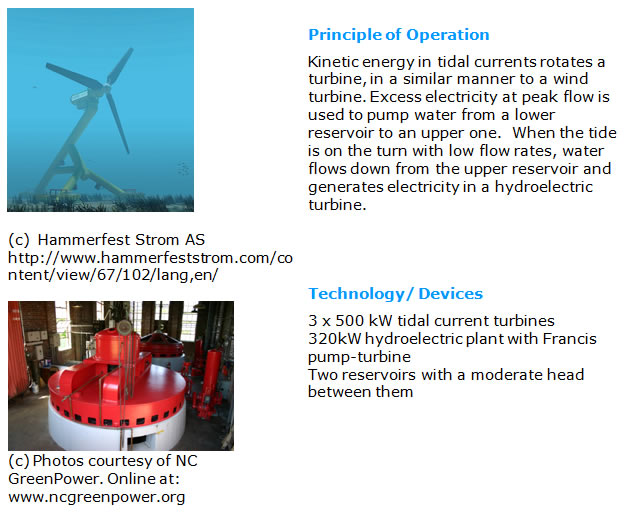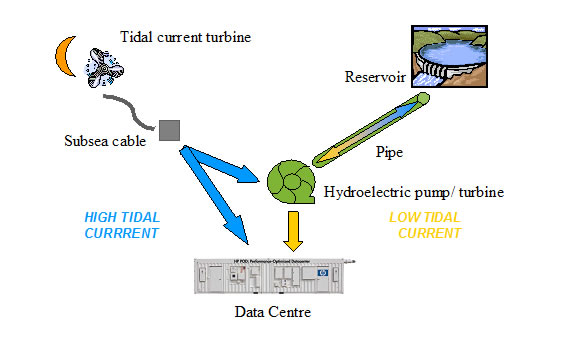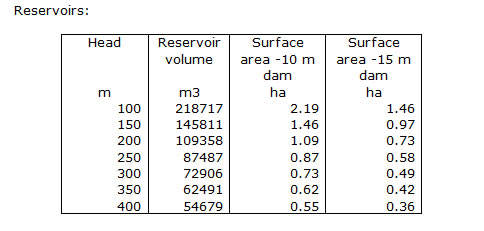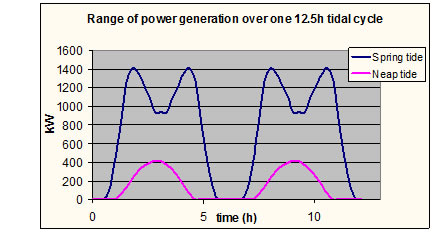Data Centres and Renewable Energy Project


Tidal Current with Hydroelectric Pumped Storage


Tidal currents vary with time, but in a predictable manner, The variation is regular over two periods: The movement of the moon relative to the earth cycles the current from maximum in one direction, through zero, to maximum in the opposite direction, and back again over a period of 12h 25 mins. On top of that, the relative movements of the sun and moon cause the maximum velocity per tide to vary over a 29.5 day period between a peak at spring tides and a low value at neap tide.
Because the variations are predictable, the amount of storage required to cover for low turbine output is also predictable; and because the basic tidal cycle is half a day, the total storage required is moderate. This makes hydroelectric pumped storage, the most efficient and established form of energy storage, a good option to pair with tidal current.

With this arrangement, the turbines operate at a load factor of 34% and storage capacity is minimised, at 5 days of operation. The longest period when the data centre is supplied from the reservoir is 9.3 hours.
Tidal current technology is still developing, and none are commercially available at present. However, many devices are being tested around the world (1), and some are now connected to the grid in full-scale trials. Companies with full scale grid trials include Atlantis in Singapore, Hammerfest Strom in Norway, MCT in N Ireland, and Open Hydro in Orkney. Some of these are expected to become commercial in the near future; Atlantis has already formed a joint venture with a data centre developer, IVI, to power a ‘blue’ data centre in Scotland (2).
Requirements
Location characteristics (3):
Max current velocity at spring tide Vsp 3.45m/s
Max current velocity at neap tide Vnp 1.72m/s
Water depth 35m
( Shetland, Yell Sound E or Bluemull Sound)

Key Assumptions
Tides (4):
Tidal period: 12h 25 mins; sinusoidal variation of velocity
Lunar period: 57 tidal periods: sinusoidal variation of maximum velocity
Turbine:
Rated power 500MW, rated speed 2.6m/s – note, the rated speed should be less than Vsp in order to generate reasonable power at neap tide

Turbine selected: Atlantis AS500 (5)
Diameter: 16m
No of blades per rotor: 3
Height of rotor above sea bed 10m (estimated from photograph)
Rotation speed 13 revs/min
Turbine power output characteristics:
Cp profile assumed same as for wind turbine (4)
Tip Speed Ratio for optimum power 4.20
Efficiency factors: yaw 0.85
fouling 0.83
generation 0.9
Storage (6):
Efficiency of storing 60%
Efficiency of generating 65%
Minimum level in storage 5%
Calculations are in the attached spreadsheet
Issues
- The resource exists only at limited locations – however these include Caithness, Orkney and Shetland
- Turbines need to be located outside shipping lanes
- Cavitation can damage the turbine if the water is not deep enough and the tip is moving fast – if the tip is less than 20m under the water surface, the maximum speed is 8m/s
- Fouling through algae or shellfish will degrade performance. This can be controlled by anti-fouling coatings and by regular cleaning; however this need to be done by changing out a turbine quickly during slack tide otherwise the energy supply is interrupted.
- If turbines are not exactly aligned with the current direction they can lose power
- The technology is still developing so there is no long term experience of how well the equipment survives in the open sea or how frequently it might break down
- Civil engineering work involved in building dams for the pumped storage scheme is expensive – although not as expensive as other forms of storage.
- Potential extra connectivity costs as the data centre should be site close to where the power cable from the turbines emerges from the sea.
References used in this page:
(1) O'Rourke, F; Boyle, F; Reynolds A; 2010: Marine current energy devices: Current status and possible future applications in Ireland, Renewable and Sustainable Energy Reviews, vol 14, pp1026–1036
(2) Renewable Energy News 2009: Atlantis Resources Corporation, Internet Villages International on track to build blue data centre, http://www.newenergyworldnetwork.com/renewable-energy-news/by_technology/energy_storage/atlantis-resources-corporation-internet-villages-international-on-track-to-build-blue-data-centre.html , accessed 15 February 2010
(3) Tidal energy in the Pentland Firth 2008 Pre-feasibility study for Pentland Alliance, Tocardo BV, February
(4) Twidell, J; Weir, T: 2006: Renewable Energy Resources, 2nd ed, Taylor & Francis, pg 38
(5) Atlantis AS 500, http://www.atlantisresourcescorporation.com/marine-power/atlantis-technologies/as-series.html, accessed 15 March 2010
(6) Electricity Storage Association website http://www.electricitystorage.org/site/technologies/pumped_hydro/
accessed 10 April 2010